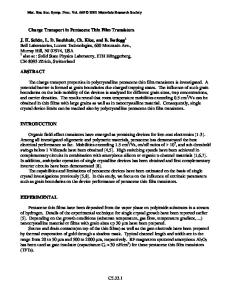Charge Transport in Low Stress Si-rich Silicon Nitride Thin Films
- PDF / 64,387 Bytes
- 6 Pages / 612 x 792 pts (letter) Page_size
- 34 Downloads / 290 Views
Charge Transport in Low Stress Si-rich Silicon Nitride Thin Films S. Habermehl and C. Carmignani, Sandia National Laboratories, Microelectronics Development Lab, Albuquerque, NM 87185
ABSTRACT Field dependent bulk charge transport in Si-rich, low stress silicon nitride thin films is studied in correlation to the local atomic Si-N bond strain. Across a range of film compositions varying from fully stoichiometric Si3N4 to Si-rich SiN0.54, Poole-Frenkel emission is determined to be the dominant charge transport mechanism with the PooleFrenkel barrier height found to decrease concomitantly from 1.10 to 0.52 eV. Across the same composition range the local residual Si-N bond strain, as measured by FTIR spectroscopy, is observed to vary from 0.006 to –0.0026. Comparison of the barrier height to the residual strain reveals a direct correlation between the two quantities. It is concluded that reductions in the Poole-Frenkel barrier height are a manifestation of compositionally induced strain relief at the molecular level. Reductions in the barrier height result in increased Poole-Frenkel emission detrapping rates and consequently higher leakage currents in Si-rich films. INTRODUCTION Low stress silicon nitride thin films exhibit a useful combination of chemical, elastic and dielectric properties [1-3]. As a result they are frequently used in the production of MEMS components such as actuators and sensors [4]. However, under an applied electric field thin films of Si-rich silicon nitride can exhibit relatively high leakage currents that may be detrimental in certain applications. Figure 1 depicts three possible charge leakage mechanisms typical to finished MEMS components. Though not studied extensively, surface conduction between adjacent poly-Si electrodes can be a source of current leakage. It can be effectively mitigated through a judicious combination of surface passivation and packaging techniques. Another possible source of leakage is a defect mediated mechanism. Defects that form in the Si-rich nitride during high temperature processing can bridge between poly-Si electrodes causing an effective electrical short [5]. This failure mechanism can be mitigated with disciplined process control and process integration techniques. The third leakage mechanism is bulk charge transport through the Si-rich nitride. Bulk transport is an intrinsic property of the film and is not easily mitigated. Understanding bulk charge transport phenomena in Sirich silicon nitrides is the subject of investigation in this paper. Charge transport in fully stoichiometric Si3N4 thin films has been determined to be governed by Poole-Frenkel emission [6,7]. The methodology used in these referenced studies has been applied here to Si-rich silicon nitride, SiNx, thin films with the resulting determination that Poole-Frenkel emission is also the dominant charge transport process. It is observed that the Poole-Frenkel barrier height, ΦB, is strongly dependent upon the film composition. Comparison of the barrier height to the residual film strain for vari
Data Loading...

